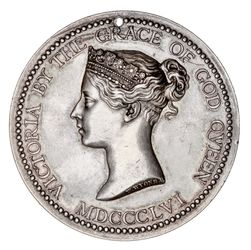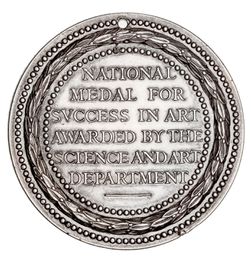Sporting & General Medals, Badges & Awards (Part 1) -
Lot 694 eSale Sporting & General Medals, Badges & Awards (Part 1) - A
Estimate $280
Bid at live.noble.com.au
GREAT BRITAIN, National Medal For Success In Art, struck in silver (54mm), by W.Wyon, pierced at top, rim impressed 'A.D.Riley/South Kensington/Stage 22D/1878' (Eimer 1511). Toned, edge nick, extremely fine.
Arthur Dewhurst Riley was born in Accrington, Lancashire, England, on 18 February 1860, the son of Reuben Dewhurst Riley, a master house-painter, and his wife, Jane Miller. Arthur attended local schools before going to the National Art Training School in South Kensington (later the Royal College of Art), London, from 1874 to 1881. After graduating with high honours he immediately emigrated to Australia, arriving late in 1881 or early in 1882. On 10 September 1882 he married Grace Nancy Dewhurst in Melbourne; they were to have two children - a boy and a girl. Riley became an instructor in a large art school and was appointed an art examiner for New South Wales.
In 1885 Arthur and Grace Riley moved to Wellington, New Zealand, where Arthur had been appointed drawing master for the Wellington Education Board; this allowed him to begin special technical classes supported by fees. As a result, in 1886 Riley was able to start Wellington's first school of design occupying three rooms in a Featherston Street building. It was an immediate success. Riley trained teachers to draw, and offered a wide range of classes to the fee-paying public. Courses included the study of the great masters, modelling, house decoration, paper hanging, casting, wood and stone carving, and conventional painting in oils and watercolours. In later years many more courses were added, such as commercial subjects, mathematics, English and even Latin.
The first year set the pattern for the future. The school expanded rapidly, although it was always underfunded, and accommodation was always inadequate. Teachers were underpaid and mostly untrained. Courses were varied and flexible, changing to meet local needs, so that in spite of the difficulties community support was strong.
Riley soon impressed people with his administrative abilities, ideas and youthful energy, and was respected both as an educator and as a person. Always well dressed, he did not fit the stereotype of artist as rebel. In appearance he was distinguished, with a smartly trimmed beard and a handlebar moustache, but no hair - he was bald by 30. As an artist he was interested in industrial design rather than conventional landscapes, and he was one of the few who insisted that Maori motifs and the local environment should be reflected in the work of New Zealand artists.
Riley became a leading advocate of planned technical education, arguing that vocational training should not be left to chance if New Zealand was to compete with other countries. He strongly opposed the narrow academic bias of secondary school education. After visiting England in 1898 Riley urged the Liberal government to set up technical colleges for able young people who could find neither work nor places in the exclusive secondary schools. He recommended better funding systems for technical education, the establishment of agricultural colleges, the teaching of applied design as well as fine arts, the introduction of manual instruction and homecraft courses, and that apprentices be given recognition for their evening-class studies.
Riley's views had a direct influence on the Manual and Technical Instruction Act of 1900 which provided more resources for vocational training and gave technical schools the right to teach almost any subject. The act also led to the conversion in 1905 of the Wellington Technical School (the new name of his Wellington School of Design) into New Zealand's first coeducational multi-purpose day school.
In 1903 Riley was at the high point of his career. His achievements were widely respected and his example was widely followed. However, he decided it was time to put personal and family interests ahead of his commitment to what was a financially unrewarding profession. He resigned that year and was never again involved in educational activities. Instead he began a new and successful career as a businessman, becoming a partner in a company importing engineering and electrical equipment. Around 1910 Riley formed his own importing firm and was the sole New Zealand agent for about 20 British manufacturing firms. In partnership with G. H. Grapes he obtained the New Zealand agency for the Albion Motor Car Company of Glasgow. They represented several other automotive and tyre companies, with sufficient success to open branches in Dunedin, Christchurch and Auckland.
Arthur Riley died at sea near Pitcairn Island on board the Rotorua on 29 August 1929, returning from a trip to England. Grace Riley died at Wellington in 1947.
(Courtesy Noel Harrison, Dictionary of New Zealand Biography, vol 2, 1993).
With research.
Estimate / sale price does not include buyer's premium (currently 22% including GST) which is added to hammer price. All bids are executed on the understanding that the Terms & Conditions of sale have been read and accepted. For information on grading and estimates please refer to the Buying at Auction advice.
Quick find
View a lot by number and sale.
Adjacent lots
Lot 692
ROYAL NEW ZEALAND CORPS OF SIGNALS, 75th Anniversary, 1996, in bronze, 51mm (M&P.NZCC/AR/21, previously MacM.1996/1). ...
Estimate $70
Lot 693
ROYAL NEW ZEALAND ENGINEERS, Centenary, 2002, struck in pewter (40mm), no maker (Millard Manufacturing) (M&P.NZCC/AR/35). ...
Estimate $40
Lot 694 This lot
GREAT BRITAIN, National Medal For Success In Art, struck in silver (54mm), by W.Wyon, pierced ...
Estimate $280
Lot 695
AUCKLAND SOCIETY OF ARTISTS, struck in bronze (45mm), by (Anton Teutenberg, Auckland), design shaved down ...
Estimate $240
Lot 696
AUCKLAND SOCIETY OF ARTS, c1880s, struck in silver (45mm), by A.Teutenberg, Auckland N.Z., ring top ...
Estimate $980

